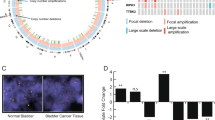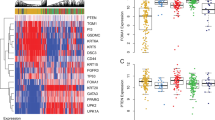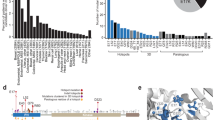Abstract
The phosphatidylinositol-3-kinase (PI3 kinase)-AKT pathway is frequently activated in cancer. Recent reports have identified a transforming mutation of AKT1 in breast, colorectal, ovarian and lung cancers. We report here the occurrence of this mutation in bladder tumours. The AKT1 G49A (E17K) mutation was found in 2/44 (4.8%) bladder cancer cell lines and 5/184 (2.7%) bladder tumours. Cell lines expressing mutant AKT1 show constitutive AKT1 activation under conditions of growth factor withdrawal. We also detected a novel AKT1 mutation G145A (E49K). This mutation also enhances AKT activation and shows transforming activity in NIH3T3 cells, though activity is weaker than that of E17K. Enhanced activation of AKT1 when E17K and E49K mutations are in tandem suggests that they can co-operate.
This is a preview of subscription content, access via your institution
Access options
Subscribe to this journal
Receive 50 print issues and online access
$259.00 per year
only $5.18 per issue
Buy this article
- Purchase on Springer Link
- Instant access to full article PDF
Prices may be subject to local taxes which are calculated during checkout



Similar content being viewed by others
References
Aveyard JS, Skilleter A, Habuchi T, Knowles MA . (1999). Somatic mutation of PTEN in bladder carcinoma. Br J Cancer 80: 904–908.
Bellacosa A, Chan TO, Ahmed NN, Datta K, Malstrom S, Stokoe D et al. (1998). Akt activation by growth factors is a multiple-step process: the role of the PH domain. Oncogene 17: 313–325.
Bleeker FE, Felicioni L, Buttitta F, Lamba S, Cardone L, Rodolfo M et al. (2008). AKT1(E17K) in human solid tumours. Oncogene 27: 5648–5650.
Bozulic L, Surucu B, Hynx D, Hemmings BA . (2008). PKBalpha/Akt1 acts downstream of DNA-PK in the DNA double-strand break response and promotes survival. Mol Cell 30: 203–213.
Brugge J, Hung MC, Mills GB . (2007). A new mutational AKTivation in the PI3K pathway. Cancer Cell 12: 104–107.
Cairns P, Evron E, Okami K, Halachmi N, Esteller M, Herman JG et al. (1998). Point mutation and homozygous deletion of PTEN/MMAC1 in primary bladder cancers. Oncogene 16: 3215–3218.
Calleja V, Alcor D, Laguerre M, Park J, Vojnovic B, Hemmings BA et al. (2007). Intramolecular and intermolecular interactions of protein kinase B define its activation in vivo. PLoS Biol 5: e95.
Cappellen D, Gil Diez de Medina S, Chopin D, Thiery JP, Radvanyi F . (1997). Frequent loss of heterozygosity on chromosome 10q in muscle-invasive transitional cell carcinomas of the bladder. Oncogene 14: 3059–3066.
Carpten JD, Faber AL, Horn C, Donoho GP, Briggs SL, Robbins CM et al. (2007). A transforming mutation in the pleckstrin homology domain of AKT1 in cancer. Nature 448: 439–444.
Dong B, Valencia CA, Liu R . (2007). Ca(2+)/calmodulin directly interacts with the pleckstrin homology domain of AKT1. J Biol Chem 282: 25131–25140.
Hennessy BT, Smith DL, Ram PT, Lu Y, Mills GB . (2005). Exploiting the PI3K/AKT pathway for cancer drug discovery. Nat Rev Drug Discov 4: 988–1004.
Kim MS, Jeong EG, Yoo NJ, Lee SH . (2008). Mutational analysis of oncogenic AKT E17K mutation in common solid cancers and acute leukaemias. Br J Cancer 98: 1533–1535.
Knowles MA, Habuchi T, Kennedy W, Cuthbert-Heavens D . (2003). Mutation spectrum of the 9q34 tuberous sclerosis gene TSC1 in transitional cell carcinoma of the bladder. Cancer Res 63: 7652–7656.
Kumar R, Hung MC . (2005). Signaling intricacies take center stage in cancer cells. Cancer Res 65: 2511–2515.
Laine J, Kunstle G, Obata T, Sha M, Noguchi M . (2000). The protooncogene TCL1 is an Akt kinase coactivator. Mol Cell 6: 395–407.
Landgraf KE, Pilling C, Falke JJ . (2008). Molecular mechanism of an oncogenic mutation that alters membrane targeting: Glu17Lys modifies the PIP lipid specificity of the AKT1 PH domain. Biochemistry 47: 12260–12269.
Lopez-Knowles E, Hernandez S, Malats N, Kogevinas M, Lloreta J, Carrato A et al. (2006). PIK3CA mutations are an early genetic alteration associated with FGFR3 mutations in superficial papillary bladder tumors. Cancer Res 66: 7401–7404.
Malanga D, Scrima M, De Marco C, Fabiani F, De Rosa N, De Gisi S et al. (2008). Activating E17K mutation in the gene encoding the protein kinase AKT1 in a subset of squamous cell carcinoma of the lung. Cell Cycle 7: 665–669.
Manning BD, Cantley LC . (2007). AKT/PKB signaling: navigating downstream. Cell 129: 1261–1274.
Milburn CC, Deak M, Kelly SM, Price NC, Alessi DR, Van Aalten DM . (2003). Binding of phosphatidylinositol 3,4,5-trisphosphate to the pleckstrin homology domain of protein kinase B induces a conformational change. Biochem J 375: 531–538.
Platt FM, Hurst CD, Taylor CF, Gregory WM, Harnden P, Knowles MA . (2009). Spectrum of phosphatidylinositol 3-kinase pathway gene alterations in bladder cancer. Clin Can Res (in press).
Pymar LS, Platt FM, Askham JM, Morrison EE, Knowles MA . (2008). Bladder tumour-derived somatic TSC1 missense mutations cause loss of function via distinct mechanisms. Hum Mol Genet 17: 2006–2017.
Sarbassov DD, Guertin DA, Ali SM, Sabatini DM . (2005). Phosphorylation and regulation of Akt/PKB by the rictor-mTOR complex. Science 307: 1098–1101.
Sun M, Wang G, Paciga JE, Feldman RI, Yuan ZQ, Ma XL et al. (2001). AKT1/PKBalpha kinase is frequently elevated in human cancers and its constitutive activation is required for oncogenic transformation in NIH3T3 cells. Am J Pathol 159: 431–437.
Thomas CC, Deak M, Alessi DR, van Aalten DM . (2002). High-resolution structure of the pleckstrin homology domain of protein kinase b/akt bound to phosphatidylinositol (3,4,5)-trisphosphate. Curr Biol 12: 1256–1262.
Tokuda E, Fujita N, Oh-hara T, Sato S, Kurata A, Katayama R et al. (2007). Casein kinase 2-interacting protein-1, a novel Akt pleckstrin homology domain-interacting protein, down-regulates PI3K/Akt signaling and suppresses tumor growth in vivo. Cancer Res 67: 9666–9676.
Wang DS, Rieger-Christ K, Latini JM, Moinzadeh A, Stoffel J, Pezza JA et al. (2000). Molecular analysis of PTEN and MXI1 in primary bladder carcinoma. Int J Cancer 88: 620–625.
Acknowledgements
This work was funded by a Programme grant from Cancer Research UK (C6228/A5433).
Author information
Authors and Affiliations
Corresponding author
Additional information
Supplementary Information accompanies the paper on the Oncogene website (http://www.nature.com/onc)
Rights and permissions
About this article
Cite this article
Askham, J., Platt, F., Chambers, P. et al. AKT1 mutations in bladder cancer: identification of a novel oncogenic mutation that can co-operate with E17K. Oncogene 29, 150–155 (2010). https://doi.org/10.1038/onc.2009.315
Received:
Revised:
Accepted:
Published:
Issue Date:
DOI: https://doi.org/10.1038/onc.2009.315
Keywords
This article is cited by
-
Bladder cancer
Nature Reviews Disease Primers (2017)
-
PIK3CA dependence and sensitivity to therapeutic targeting in urothelial carcinoma
BMC Cancer (2016)
-
Genetic landscape of meningioma
Brain Tumor Pathology (2016)
-
MiR-133b regulates bladder cancer cell proliferation and apoptosis by targeting Bcl-w and Akt1
Cancer Cell International (2014)



